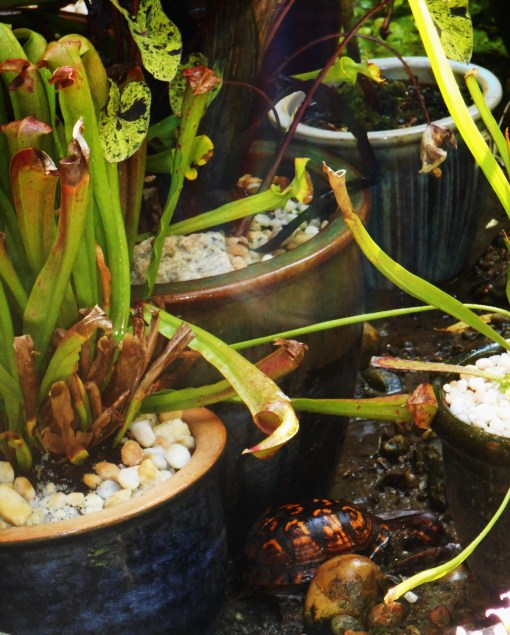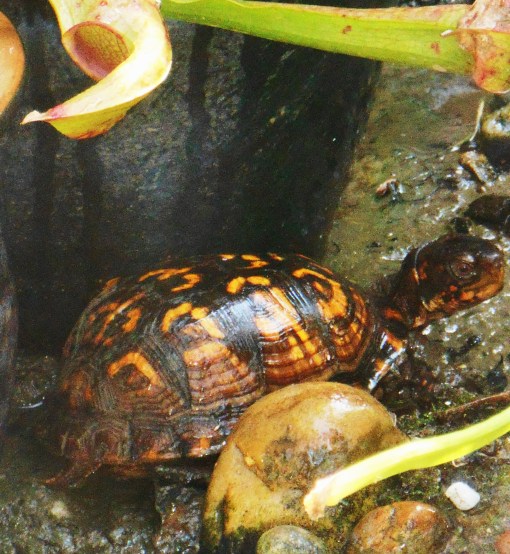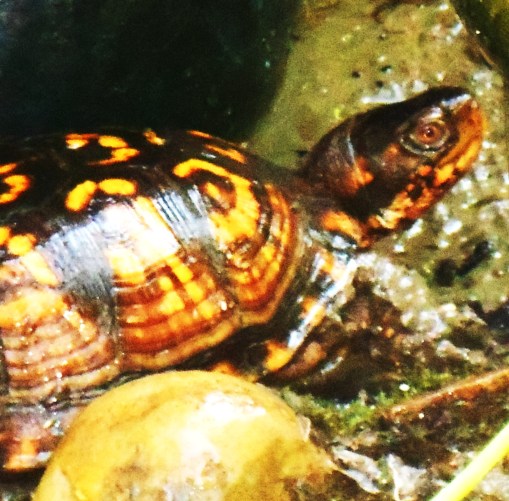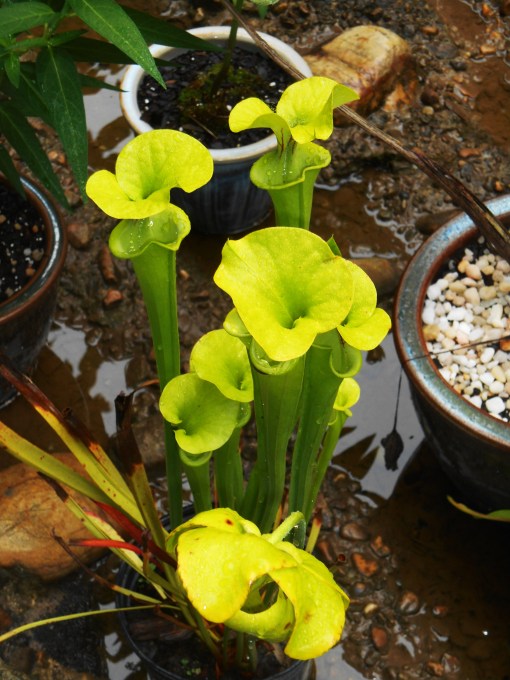
Sarracenia flava
~
Once upon a time, not so long ago, really, pitcher plants grew wild in the boggy wetlands along the Atlantic coast. They grew right around here, along the banks of the James River and the many creeks that feed it.
The yellow trumpet pitcher, Sarracenia flava, is native to our part of coastal Virginia. Most species of pitchers grow from Virginia south to Florida, and west along the Gulf coast.
Only one species, Sarracenia pupurea ssp. purpurea, grows from Virginia north to Canada and west to the wetlands around the Great Lakes. Most of these species live in bogs and wetlands at sea level, but a few species grow at higher elevations in the Appalachian Mountains from Virginia south into Georgia.
~

~
It’s rare now to find a pitcher plant growing wild. Over 97% of their habitat has been drained and developed. A few species and natural hybrids are all but extinct. These beautiful carnivorous plants are sustained these days mostly in private collections.
And the good news, gardening friends, is that these striking plants are easy to grow! Anyone with a sunny spot can participate in keeping these beautiful and unusual species going.
~

~
If you live in Zone 7 or warmer, you can grow most any of the North American pitcher plants outdoors year round. If you live in colder climes, you probably can grow the species and hybrids of Sarracenia purpurea, Sarracenia oreophila, or Sarracenia montana. Even if you live a zone or two colder than your plants are rated, you can find ways to insulate them over winter.
These easy to please plants simply want wet, acidic soil and as much sun as you can give them. Grow them in pots filled with a mix of half peat moss and half sand, or three quarters peat and 1/4 perlite or fine gravel. Keep the soil moist by growing in a glazed ceramic pot with no drainage hole, or a glazed ceramic pot with a deep, water filled saucer beneath. Peter d’Amato, owner of California Carnivores and author of The Savage Garden, recommends growing potted Sarracenias in glazed pots kept standing in 2″ of water at all times, so the soil stays evenly moist.
~

~
These are definitely tough, outdoor plants and prefer full sun. If you grow them indoors, keep them near a window with bright light for at least 6 hours a day, or in a greenhouse.
Never use commercial potting mix, compost, or commercial fertilizers with pitcher plants. Peat is closest to the soil of their natural habitat, and provides the acidic environment they require.
The only pitcher plant that has ever failed for me came from a local grower. He cut corners, and blended his own compost based soil mix rather than using good peat. He admitted this to me when I returned the plant to him the following spring after I bought it, because it hadn’t begun new growth. He replaced the plant, and I immediately re-potted it into the proper mix. It is thriving still.
~

~
There are several distinct features to the different species of pitcher plants. The pitchers can be as short as 5″-6″ or as tall as 48″ depending on the species. Each hollow pitcher is actually a leaf. The most common pitchers, the S. purpureas, are also some of the shortest. They are usually a beautiful red or purple and have red flowers.
S. flava, S. leucophylla and S. oreophila produce some of the tallest pitchers. Some pitchers stand up tall, and others form recumbent rosettes of pitchers. Pitchers may have wide mouths with fancy, frilly openings, or may have wide open mouths that catch the rain. S. minor and S. psittacina pitchers have hooded openings.
~

~
Some pitchers are mostly green, others are red or purple. S. Leucophylla have white around the openings to their pitchers. S. flava is also called the yellow pitcher plant, and they are a beautiful chartreuse yellow.
Sarracenia flowers may be red, purple, white, peach, yellow or some combination of these colors. There are so many interesting hybrids and cultivars that a pitcher plant enthusiast has many choices of which plants to grow.
I ordered two new pitcher plants from Sarracenia Northwest, in Portland OR, this spring. I’m now watching S. ‘Bug Bat’ and S. leucophylla ‘Tarnok’ begin to grow. Both were very carefully packaged and arrived in growth and in perfect condition.
~

~
And then earlier today, I found an interesting carnivorous plant terrarium kit at Lowes, with a dormant Sarracenia and a dormant Dionaea, or flytrap; little bags of peat and sphagnum moss. There were potting instructions and a clear plastic box to hold the plants until they begin to grow. At under $10.00, this looked like a pretty good value.
~

Our newest pitcher plant came in a carnivorous plant terrarium kit found at Lowes. I’ve planted it, and a dormant flytrap in this bowl given to us by a potter friend.
~
I potted the little dormant plants in my own mix of peat and sand, in a beautiful bowl our potter friend Denis Orton gave us at the holidays. The bowl has no drainage and is a perfect first home for both plants. They may need potting on next year or the next, but that is the way of things, isn’t it?
It will be a surprise to see which species of pitcher plant grows from this start, but I’m guessing it is most likely the most common, S. purpurea.
~

~
Pitcher plants have various ways of luring insects into their open mouths. There are nectar trails that lure insects up the pitchers and into their open mouthed leaf. Each species has ingenious ways to keep them from escaping again. These plants catch and digest every sort of insect from crawling ants to mosquitoes and flies.
~

~
There is no shortage of insects in our May garden! We have come to the part of summer haunted by every sort of bug imaginable, and it’s fabulous irony that one of our most beautiful native perennials also helps control the bug problem!
Our little collection of pitcher plant is growing now, and it is fabulous to admire their fresh new pitchers on this very muggy Friday afternoon. I am looking forward to watching the new ones grow and show their special colors and forms.
~

Pitcher plant, Sarracenia leucophylla, native to the Southeastern United States
~
If you’ve not yet tried growing pitcher plants, I hope you’ll think about giving them a try. These endangered species need all the help adventurous gardeners will give to keep them going on into the future.
~

~
Woodland Gnome 2017
Happiness is contagious! Let’s infect one another!
~
~
For the Daily Post’s
Weekly Photo Challenge: Heritage




















































